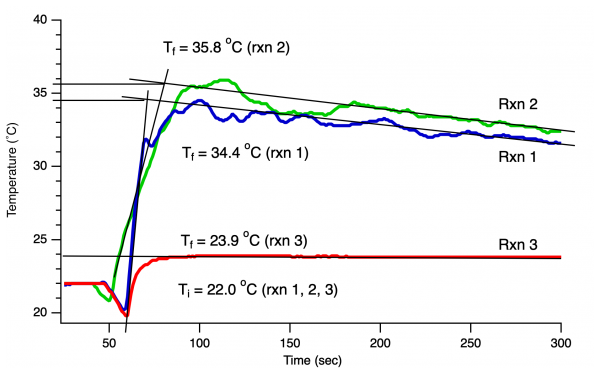Difference between revisions of "PChem312 s22 w11"
| Line 13: | Line 13: | ||
==Tuesday, March 22nd== | ==Tuesday, March 22nd== | ||
| − | Welcome to an online PChem lab activity. This is a standard calorimetry lab | + | Welcome to an online PChem lab activity. This is a standard calorimetry lab where we determine the @DHrxn fro three related, but different reactions. We have done previously in gen chem, but replaced it with the burning of food stuff because setting Cheetos on fire is much more exciting...now you get to do the more boring lab now. |
If we were doing this in the lab, you would collect temperature vs time data for a set of three reactions: | If we were doing this in the lab, you would collect temperature vs time data for a set of three reactions: | ||
| Line 20: | Line 20: | ||
:NaOH (aq) + HCl (aq) --> NaCl (aq) + H<sub>2</sub>O (l) | :NaOH (aq) + HCl (aq) --> NaCl (aq) + H<sub>2</sub>O (l) | ||
| − | The data would | + | The data would look like this (collected by A. Trenttin - Fall 2020): |
:[[File:Solution_Cal_data.png|600px]] | :[[File:Solution_Cal_data.png|600px]] | ||
| − | These reactions are done in a "coffee cup calorimeter" and although the insulating properties of the cups is not great, we can compensate for this by carrying out the T<sub>f</sub> analysis shown on the graph. | + | These reactions are done in a "coffee cup calorimeter" and although the insulating properties of the cups is not great (notice the temperature drops after reaching a max), we can compensate for this by carrying out the T<sub>f</sub> analysis shown on the graph. By fitting the data to identify the rate of heat loss, we can determine the T<sub>f</sub> values indicated on the graph. |
''Note: some of the following values are estimates...you must use your values that show up in your lab notebook carbon copy.'' | ''Note: some of the following values are estimates...you must use your values that show up in your lab notebook carbon copy.'' | ||
Revision as of 15:03, 22 March 2022
Welcome to a week of online PChem! As you know, 11 MC students, faculty and staff are attending the 258th bi-annual ACS meeting in San Diego, CA...YES there have been 257 previous ACS meetings (2 per year). At this years meeting there are ~11,500 abstracts/presentations, ~9,000 in-person attendees, and another ~3,000 virtual registrants.
So, in my absences, i ask you to complete the following work. On Monday March 28th, you will bring to class all of the completed work listed below in a form that can be turned in, ie. hard copies.
Monday, March 21st
Worksheets from Friday...
- Worksheet 1: Fuel Worksheet
- Worksheet 2: Thermite Worksheet
New worksheet...
- Worksheet 3: Home Heating
Tuesday, March 22nd
Welcome to an online PChem lab activity. This is a standard calorimetry lab where we determine the @DHrxn fro three related, but different reactions. We have done previously in gen chem, but replaced it with the burning of food stuff because setting Cheetos on fire is much more exciting...now you get to do the more boring lab now.
If we were doing this in the lab, you would collect temperature vs time data for a set of three reactions:
- NaOH (s) --> NaOH (aq)
- NaOH (s) + HCl (aq) --> NaCl (aq) + H2O (l)
- NaOH (aq) + HCl (aq) --> NaCl (aq) + H2O (l)
The data would look like this (collected by A. Trenttin - Fall 2020):
These reactions are done in a "coffee cup calorimeter" and although the insulating properties of the cups is not great (notice the temperature drops after reaching a max), we can compensate for this by carrying out the Tf analysis shown on the graph. By fitting the data to identify the rate of heat loss, we can determine the Tf values indicated on the graph.
Note: some of the following values are estimates...you must use your values that show up in your lab notebook carbon copy.
Reaction 1 - data
- NaOH (s) --> NaOH (aq)
- - 3.51 g NaOH --> (40.00 g/mol) --> 0.0878 moles NaOH (s)
- - ΔT = 34.4 - 22.0 = 12.4 oC
Reaction 2 - data
- NaOH (s) + HCl (aq) --> NaCl (aq) + H2O (l)
- - 3.43 g NaOH --> (40.00 g/mol) --> 0.0856 moles NaOH (s)
- - ΔT = 35.8 - 22.0 = 13.8 oC
Reaction 3 - data
- NaOH (aq) + HCl (aq) --> NaCl (aq) + H2O (l)
- - 1.76 g NaOH --> (40.00 g/mol) --> 0.0440 moles NaOH (s)
- - ΔT = 23.9 - 22.0 = 1.9 oC
Wednesday, March 23rd
Friday, March 25th
PLEASE stay tuned...we may have class on this day depending on our return travel plans.
